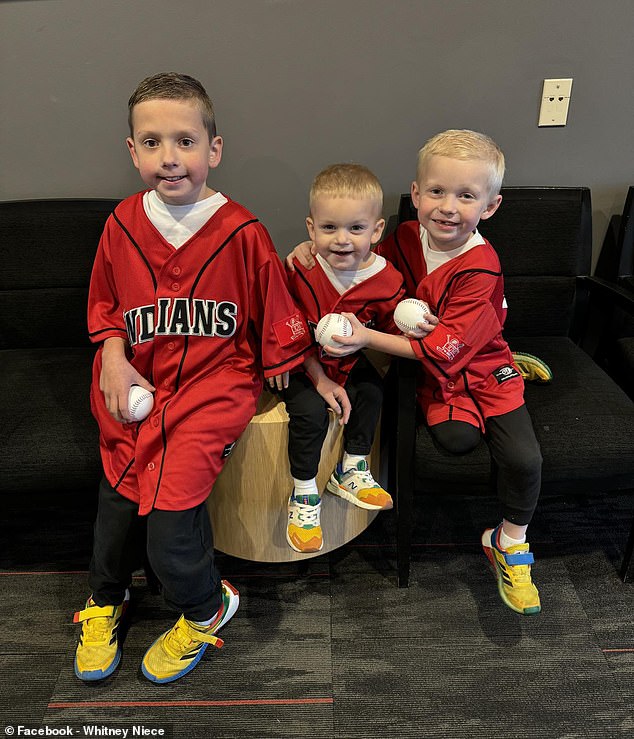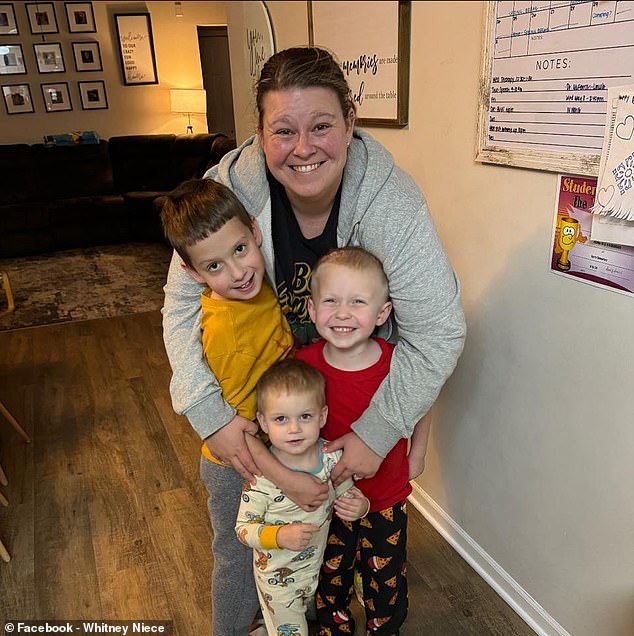All three of our sons were diagnosed with the same rare brain disease after mysterious headaches
All three children in an Indiana family have been diagnosed with a rare brain disorder that can cause seizures and paralysis.
The children – aged two, five and 10 – were struck by seemingly random attacks of dizziness, headaches and illness that neither the doctors nor their parents linked.
Whitney and Ron Niece noticed something was wrong in June 2022 when their youngest son, Remley, wasn’t as rambunctious as usual and hadn’t had a pee in more than 24 hours.
They took him to the hospital where doctors performed an MRI of the boy’s brain, which revealed he had a Chari malformation, a one-in-a-thousand abnormality that causes a hernia at the base of the brain that puts pressure on the brain. spinal cord.
Lincoln, Norrin and Remley Niece were all diagnosed with Chiari Malformation, a rare condition that causes the brain to extend into the spinal canal

Each of the boys underwent brain surgery to correct the condition, which only affects one in a thousand people worldwide
Less than a year later, in February 2023, Lincoln, now 10, developed headaches and was also diagnosed with Chari deformity.
And just as Remley was about to undergo surgery about six months later, five-year-old Norrin began experiencing the same headaches as his siblings, and he too was diagnosed.
Since their diagnosis, all three boys have undergone “multiple procedures and surgeries” to correct their condition, which is usually caused by a malformed or small skull putting pressure on the brain.
The boys’ father, Ron Nicht, told the Greenfield Daily Reporter: ‘It doesn’t get any easier, even after multiple procedures and surgeries.’
According to the Mayo Clinic, there is some evidence that Chiari malformations run in families, but research is still in its early stages.
Chiari malformation typically causes problems such as headaches, neck pain, poor coordination, dizziness, and difficulty swallowing.
But some people with the condition may never show symptoms or be diagnosed, leading doctors to believe the condition is more common.
There are five types of Chiari malformations, with type 1 being the most common and benign, while type 3 is the rarest and most serious.
This type is associated with debilitating and life-threatening complications.
It is unclear which type the Niece boys have.
Cousin’s siblings all suffered from frequent headaches and vomiting, and Remley often fell over because his legs gave out randomly.
Despite his similar symptoms, the nieces initially did not suspect the condition in Lincoln and attributed the symptoms to his congenital heart condition. It is unclear which defect he has.
Lincoln was the first of the siblings to undergo corrective surgery in March 2023 to prevent his brain from pressing against his spinal cord.
But by the time Lincoln had surgery, Remley was showing signs of delayed development, such as trouble walking and speaking, so he was booked for surgery in August.
That same month, Norrin received his diagnosis after a bout of constant headaches. He had surgery in January 2024.

The boys’ mother, Whitney Niece (pictured here), said the family is now focused on raising awareness about the condition, which can cause headaches attributed to more common causes
Mrs. Niece told the Greenfield Daily Reporter that the family has tried to maintain a positive attitude toward the boys, but when Lincoln underwent his first surgeries, she sat in the hospital hallway and cried so her sons couldn’t see her.
And while she and her husband have tried to be transparent with their sons about their symptoms and surgeries, they try to make the whole ordeal feel less terrifying.
For Norrin, his parents told him he would go to sleep and wake up with a few “owies.”
All three boys underwent Chiari Malformation Decompression, the standard treatment for the condition. The surgery involves removing a three-centimetre section of bone towards the back of the skull to relieve pressure.
However, Norrin and Remley each had complications after the procedure. Both boys developed hydrocephalus, a buildup of fluid in the brain, requiring drains to be placed to remove the excess fluid.
All three boys completed their surgeries in January 2024 and have been healthy ever since.
According to Weill Cornell Medicine, almost all patients who undergo decompression surgery experience partial or total improvement in their symptoms.
Despite the restrictions necessary to prevent the siblings from bumping their heads, such as not riding bikes or jumping on the trampoline, the family hopes they can become “typical kids” again. It is unclear how long they will face restrictions.
Ms Niece said she is focused on raising awareness about the condition, which she had never heard of until her sons were diagnosed.
She said, “So if we can help another child who may be suffering from headaches and has died multiple times, then that’s a win in my eyes.
“Because a lot of people go in looking for something that causes a headache, and unless you specifically say you’re looking for Chiari, it can be portrayed as something else.”
